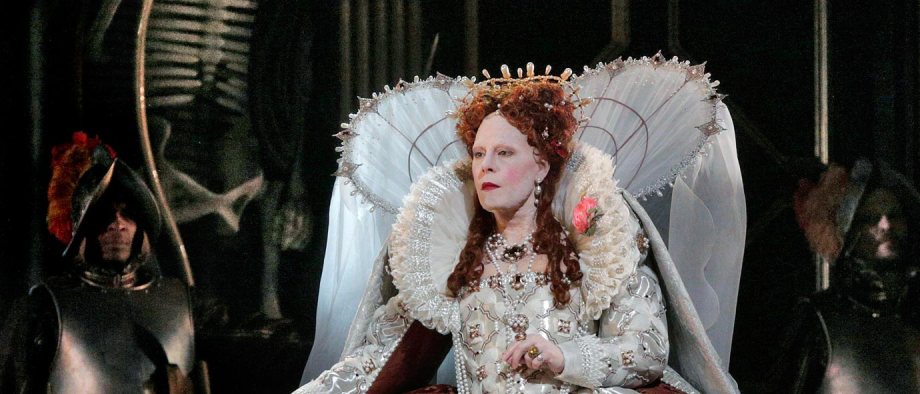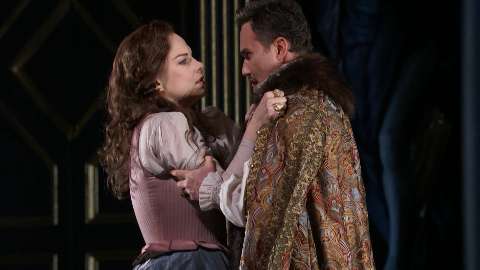When you are faced with a production of Donizetti’s Roberto Devereux, it is good to keep in mind that yes, it is ridiculous. It is ridiculous on the grand scale – it has the distinction of being (I’m pretty sure) the only story based on the life of the Earl of Essex that includes his execution but does its best to avoid talking much about the abortive rebellion he led in early 1601 that according to most non-Donizetti’s-librettist schools of historical scholarship was the primary reason he was executed. Also it leaves out the part where he tried to shift part of the blame for the rising to his sister Penelope (I am not making this up), which I suspect gives you a sense of why Donizetti’s librettist decided to leave this and many other things out of the libretto.
It is also ridiculous on the small scale – the ending has Elizabeth basically drop dead after she realizes she was wrong to execute Essex. Given that in this version, she has him executed basically because she’s mad at him for loving another woman, I suppose maybe she was embarrassed. You know how sometimes you’ve momentarily wanted to drop dead, when you’ve done something really stupid and everyone in the room knows? Well it may be that if you’re an anointed monarch, you can actually do this. But of course, you can only do it the once.
Also, it seems the Italian language cannot accommodate the word “Earl.” The libretto makes him a count (conte) instead. (I wonder if it’s like how German speakers have so much trouble with the word “squirrel”? Imagine a scene of a WWII movie in which an apprehended German undercover spy is being interrogated and they’re trying to force him to break cover. They show him a picture of a squirrel. “What is this?” “A marmoset!” “No!” “A small fox!” “No! Say it!” “A chipmunk!” “You know very well that is not a chipmunk! It is a SQUIRREL! Say it! Squirrel!” [German spy, breaking down in tears, defeated]: “I can’t. You know I cannot say it. Squi-rell. There. You see my accent has failed. It’s over now.”)
But never mind about that right now. Suffice it to say that Roberto Devereux is a very silly opera. It is also a very entertaining opera, if you do it right. The Met has done it mostly right. The production by David McVicar is cousin to his stagings of Maria Stuarda and Anna Bolena. It is not going to set anyone’s hair on fire, for better or for worse. The set is visually very economical, with a central middle section that can move backwards and forwards to create larger or smaller spaces, and a gallery on each side. According the booklet, the dark and basically Tudor-looking interior thus created is intended to be Nonsuch Palace rather than Westminister as indicated in the libretto. The items on stage that catch one’s eye are the artwork on the moving wall, which includes a representation of death (I couldn’t see detail on that very well, since I was in the way back of the Family Circle) and the glimmering chandeliers, which – it’s sort of cute, but I don’t think it means anything – visually double the ones in the auditorium. The council table in Act III doubles a similar platform/table in McVicar’s Maria Stuarda, and here, elderly Elizabeth walks with a limp, an echo of that bizarre gait in the other opera. The stage is mostly fairly dim, with daylight appearing only in the council chamber in Act II, so that it can slowly turn to setting sunlight as we are told that Essex will die tomorrow. And at the opera’s end, the rear section of the set lifts away completely to reveal a bare wall, against which which rests (again, I think I should have brought the binoculars) a marble coffin on a bier. It’s Elizabeth’s, and a good thing too, since, as noted, she drops dead at the opera’s end. We have seen it before – it slides out at the beginning, and the chorus/courtiers bow to it.

I went to this performance for two reasons. One, I find this silly opera enormously entertaining and two, I enjoy hearing Sondra Radvanovsky sing. I knew about what to expect, and I got it. The first confrontation scene with Essex (Matthew Polenzani) in Act I didn’t have quite the ping I expected, but the previous aria, “l’amor suo mi fè beata,” was done well. Things really got going by the end of Act II, with “Va, la morta sul capo ti pende” – I got to hear that wonderful Radvanvosky gleam. (And this is one of the unintentionally funny moments in the opera. The fatal blue scarf has been revealed, Nottingham has realized it’s his wife’s, Essex has realized he’s in deep shit and so of course he says – wait for it – “o ciel!” There’s something about the fact that you can basically predict all the “o ciel!”s in a Donizetti opera that gets me every time. And Elizabeth’s last two solo moments at the end of Act III confirmed to me why I had come to hear this.
 But the really good thing about this production is that the supporting roles are taken by some very high quality singers. In the recording of this opera that I have, it’s basically Beverly Sills and a bunch of other people, and many of the non-Beverly Sills sections of the recording are not actually that interesting. This was not the case at the Met on Saturday. Elina Garanca made me wish that Sara (Nottingham’s wife and Essex’s lost love) had more music, and perhaps more exciting music – that smooth, solid voice of hers was a pleasure to listen to from beginning to end. And Mariusz Kwiecien was a dramatic and interesting Nottingham; there’s an aria of his that repeats the line “santa voce d’amistà” over and over again, and if the baritone singing this bit is not interesting and mellifluous, one wants to explode something around the fourth or fifth or tenth iteration of this line of text. Fortunately Kwiecien was both mellifluous and interesting. Polenzani in the title role also had some really fine moments, particularly Essex’s last aria(s) before he is taken away to execution.
But the really good thing about this production is that the supporting roles are taken by some very high quality singers. In the recording of this opera that I have, it’s basically Beverly Sills and a bunch of other people, and many of the non-Beverly Sills sections of the recording are not actually that interesting. This was not the case at the Met on Saturday. Elina Garanca made me wish that Sara (Nottingham’s wife and Essex’s lost love) had more music, and perhaps more exciting music – that smooth, solid voice of hers was a pleasure to listen to from beginning to end. And Mariusz Kwiecien was a dramatic and interesting Nottingham; there’s an aria of his that repeats the line “santa voce d’amistà” over and over again, and if the baritone singing this bit is not interesting and mellifluous, one wants to explode something around the fourth or fifth or tenth iteration of this line of text. Fortunately Kwiecien was both mellifluous and interesting. Polenzani in the title role also had some really fine moments, particularly Essex’s last aria(s) before he is taken away to execution.
considering Donizetti’s librettists took so many (ridiculous) liberties with historical fact, one wonders why they bothered to pinpoint the particular historical moment? Or did they have a different relationship with history than we do?
LikeLike
If I had to guess, it’d be that they knew their audience had heard of these historical figures and knew some of the big moments (Anne Boleyn gets beheaded; Elizabeth never got married and that was a big deal; Mary Stuart was accused of plotting and also got beheaded, etc.) but they didn’t care about the details and/or assumed their audiences didn’t. It sometimes reminds me of American depictions of the Revolution, where it’s a lot of people waving muskets and shouting about liberty so as to make the audience go YEAH! MURICA! and get excited or weepy, but the narrative doesn’t bother asking questions about how the whole business really went down or why.
LikeLike
Feel free to throw Schiller under the bus for Maria Stuarda.
LikeLiked by 2 people
(of course with the caveat that history was never the point)
LikeLike
for Maria Stuarda and in general.
LikeLike
This was what was interesting about Stephen Lawless’ production. Donizetti seems to have a very pro Catholic and negative view of the Tudors, especially Elizabeth, whereas, as every skuleboy kno, the Tudors freed England from The Middle Ages, made it Protestant (yay) and Modern and set it on the road to being Top Nation. All of which we probably get more from Shakespeare than history classes. Lawless used an allegorical prelude during the overture in which, inter alia, Shakespeare appears to be responsible for the destruction of the Armada. The theme recurs at the end with the “happy conclusion” of James’ succession.
LikeLike
Interesting – I wish the Met had done a production like that rather than McVicar’s, which – well, as noted earlier, is not going to start any fires.
I wonder if the Italian censors had anything to do with how the story was handled? I know that some 19th century operas that dealt with themes like royalty, Catholicism, executions of monarchs, etc. were considered a problem, but I don’t actually know much about the specifics of how (and to what exent) censorship operated.
LikeLike
I get conte for earl but who promoted Howard of Effingham to duke and changed his wife’s name? I enjoyed RD when ot was done here. Sondra was great, Leonardo Capalbo was a revelation as Essex and Russell B and the underrated Alysson MacHardy made a fine pair of Nottinghams (nor to be confused with Bristols)
LikeLike
I know what you mean – once you start counting inaccuracies (names, titles, etc.) in these things, it’s down the rabbit hole of WTF, never to return.
LikeLike
Thanks for this review! I have a ticket to see the Live in HD encore presentation tomorrow night. (On Saturdays, a brand new cineplex shows the Met operas in 2 theaters–and both were sold out for Saturday!
LikeLike
Enjoy! I hear that the intermission interviews for that show (that those of us in the house missed) were fun too.
LikeLike
and our local fancy cinema serves wine and hors-d’oeuvres during intermission, too. Double Fun!
LikeLike
Just for the record (Italian here): Earl just doesn’t exist in Italian. Even if Donizetti had done a phonetic translation (something like “Erlo” which sounds horrifying) no one in the audience would have understood its meaning. “Conte” is merely the closest noble rank existing (or having existed) in Italy. Even wordreference agrees! http://www.wordreference.com/enit/Earl
LikeLike
Yes, I know about the rough equivalence of the two titles – thanks for the additional info!
LikeLike
Well yes. There’s a reason why the wife of an earl is styled countess in English. Curious though that they didn’t come up with say “earlwife” from fictitious Old English “eorlwif” but then I guess pre Conquest “eorl” was an office not a title and they didn’t need “eorlwif” anymore than we need “Prime Ministeress” today.
LikeLike
Squirrel can, well, cut both ways (see the Anmerkung): https://de.m.wiktionary.org/wiki/Oachkatzlschwoaf
LikeLiked by 1 person
I have enough trouble saying “Eichhörnchen”!
LikeLike